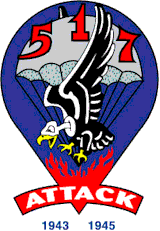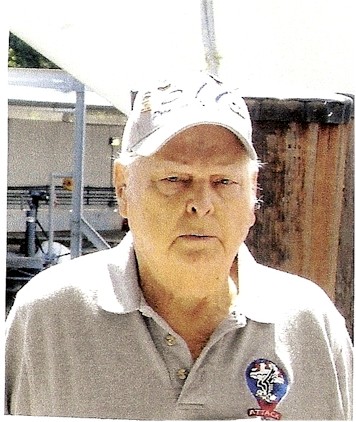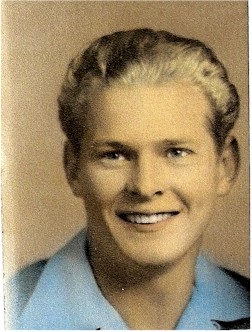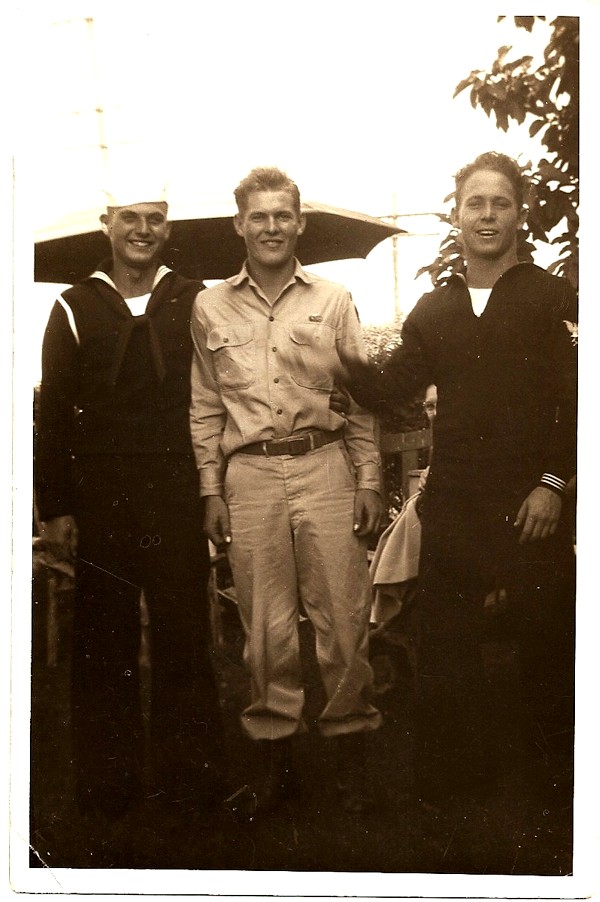 |
517th Parachute
Regimental Combat Team
Myrle Traver 2nd Battalion, F Company |
 |
I was born September 12, 1924 in Montrose, California to Cecil and Ora Mae
Traver. I have an older brother, Bill and a younger sister, Leona. My father
worked in construction so we moved to where there was work. Consequently I
attended various schools. My mother passed away when I was 16. I went to work
but continued my education until the school said that I either had to quit
working or quit school. I quit school in my junior year when I was 17.
I met Betty in April 1942 and we were married November 29, 1942. My friend Ed and I went into Los Angeles to join the Paratroops (we heard they made more money) but we were told that we would have to wait until we were drafted then we could volunteer for the Paratroops. We were inducted at Fort MacArthur, San Pedro, CA. and volunteered for the Paratroops. Six days later we were on the train headed to Camp Toccoa, GA. I had heard from a paratrooper friend that we would be required to do pushups when we got off the trucks so Ed and I practiced. Boom Boom Alicki greeted us and ordered 10 pushups. Ed and I were able to do them while the other guys struggled.
With Camp Toccoa behind us we went on to Camp Mackall, NC for more training and then to Fort Benning, GA to jump school. More training at Camp Mackall then on to Tennessee for war games, back to Camp Mackall where we were given a furlough to say our goodbyes. I was home when our first son arrived.
|
Myrle between his friend and his brother. Myrle was on furlough. |
We boarded the Santa Rosa at Newport News in Virginia and we were on our way. We arrived in Naples, Italy May 31, 1944. We were in battle in Italy until August 14th then on August 15,1944 we made our first combat jump into Southern France. We battled our way across France to the Italian border. We had been on the front lines for 94 days before we were relieved. Trains carried us to Soissons, France. The bulge started and we fought though it until February 4, 1945. Capt. Guichici,
George Flynn and I went through the biggest mine field and failed to meet Co E. We were unaware that the attack orders had been changed. After a couple of days we were sitting in a big shell hole when the Germans captured us.I was a prisoner for 64 days constantly moving ahead of the American forces. Capt. Guichici was separated from us because of his rank. They transported us in box cars, marched in large columns and as the sick fell behind the main column the guards rounded them up. I faked being sick so that I could stay and help George who was very ill. The second night out we were put in a barn and the next morning we had new guards. They started moving us west. George and I escaped along with a couple of others. The guards couldnít leave the other prisoners so they yelled for us to stop or they would shoot. We didnít stop and they didnít shoot because we were moving through retreating Germans. I was half carrying George because he was so weak. We walked through a couple of villages and ran into Pattonís tanks. What a welcome sight that was. We were taken to a field hospital and they flew us to Rheems, France. April 1945 until October 23,1945 when I mustered out I was in hospitals and rehabilitation.
I worked as an Operating Engineer and went back to night school to get my diploma. In 1973, Betty and I worked as a team managing properties in Houston, TX. I answered an ad in the paper regarding the 517th. It was the first news I had heard of the outfit in 36 years. In 1982, we attended our first reunion in Orlando, FL. We retired in 1990 and moved back to California. We came out of retirement to manage a Mobile Home Park, then retired again in 1999.
We moved to Las Vegas in 2002 and have no plans to move again. In 2004 we heard that we could write to St. Louis, MO to request the medals that I was entitled. I was surprised when I saw the Silver Star, 2 Bronze Stars, Riflemanís medal, Purple Heart and Theatre Ribbons.
We have four sons, Kenneth Myrle, Terry Lee, Wayne Warren and Darrell Allen. They have given us nine grandchildren and fourteen great-grandchildren.
 2007 in Washington, DC |
Another white parka story: Before we went down to Sospel, we were up behind "1098 hill" and we went on patrol. We heard tank guns to the south and went to see who it was. The special service forces were firing the anti-tank gun on the half track because they had some Germans bottled up in a train tunnel. I bought a white parka from one of the guys for $20.00, Guichici, George and I were captured at the Bergstein Attack and they let me keep the parka. The fur got infested with grey lice so I had to cut off the fur lining on the cuffs and hood so I could continue to wear it because we did not have blankets. When George and I escaped and repatriated by Patton's tank columns they deloused us and burnt all of our clothes. That was the end of the parka. -- Mylre Traver
From Paratroopers' Odyssey:
The Attack of Midnight, 5/6 February
After dark the 2nd and 3rd Battalions moved into attack positions. The troopers had been issued plastic fluorescent strips which were stuck to the back of their helmets; each man would follow the white blob on the helmet of the man in front. It was over- cast, moonless, and very dark. At midnight the columns moved out.
Five to six hundred yards below Bergstein both Battalions hit mine fields and concertina wire. German illuminating flares arced into the sky, and the enemy opened up with machine gun, mortar, and artillery fire.
F Company, leading 2nd Battalion backed off and called for artillery, E Company passed by on left of F and hit another minefield. The Battalion reserve -- D Company -- was committed, and ran into concealed bunkers delivering fixed machine gun fire down rows of concertina wife.
Captain Giuchici, commanding F Company, decided to get around the opposition to his front by circling to the right. F Company crawled off and disappeared. At 0230 the Battalion Headquarters lost contact with Giuchici.
On the east of the trail the 3rd Battalion, also caught in minefields and wire under heavy fire, brought down artillery without noticeable effect. a Company attempted to get forward by crawling and probing, with little success. Company H was committed, passing by on the right of G.
Allan Goodman, a squad leader of the 596th's Third Platoon, writes that:
"The 596th went in column with the 517th at the beginning of the attack, which started near Bergstein about midnight. We were advancing along a road in two long columns and were carrying timbers and planks to build some kind of crossing. The crossing never materialized and sometime during the night the timbers and planks were abandoned. The advance was supposed to be stealthy but we kept getting illuminated by enemy flares. There was nothing we could do but freeze in place and hope the German gunners did not see us ... it was the darkest night I have ever experienced ..."
Through the night the battlefield was raked with fire and lit by flares. All efforts to move forward proved futile. It was a hopeless, murderous fiasco. Men were blown up by Schu mines, Tellermines, and "Bouncing Bettys." Just before daylight the attack was called off. Leaving rifle company elements in contact, both Battalions pulled back into Bergstein.
What happened to F Company? BAR man Myrle Traver relates that:
". . . we moved out and started crawling ... machine guns and flares were keeping me scared to death. ..we finally got through the mine fields and were moving up and down mountain trails. Sometimes we would fall behind and then catch up ... after some time, I looked back and no one was following ... I ended up in a foxhole with Lieutenant Silar. He told me to keep down ... two German officers walked up. Silar raised up and shot both Germans from a three-foot range.
"Daylight was breaking, so we started to move again. A few hundred yards further we began to get shelled by our own artillery ... a couple of shells hit right among us. Captain Giuchici told Silar to stay with the wounded and for me and George Flynn to follow him. We ran and ran, Giuchici with his drum-type submachinegun in one hand like a pistol and me dragging that BAR. Flynn had an '03 sniper rifle. We stumbled on to a young German soldier ... he appeared to be about 13 years old. He begged us not to kill him and Giuchici said to bring him along.
"Where we were supposed to meet E Company there was no one. We hid in a large shell hole and waited, hoping the infantry would attack and pick us up ... we didn't know the attack had been called off . . ."
Giuchici, his two men, and their young German captive waited for an attack that never came. Fifteen to twenty other F Company men were strung throughout no-man's-land. Several were captured, but the majority made it back after wandering for a day or more through mine-infested, German-held territory.
received July 2009 from
Betty Traver

